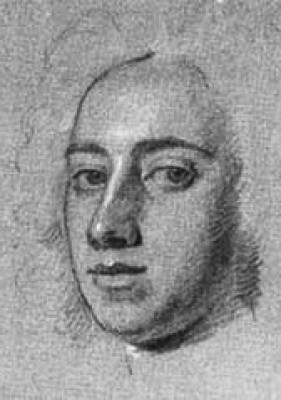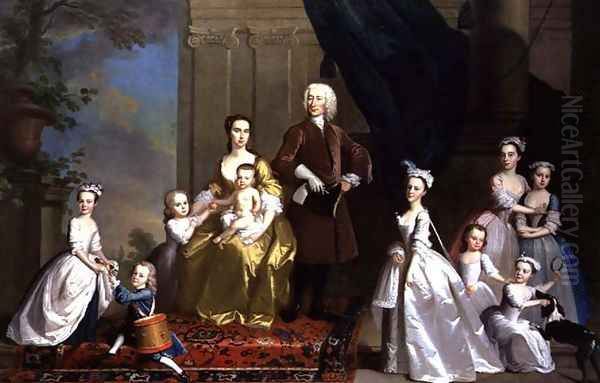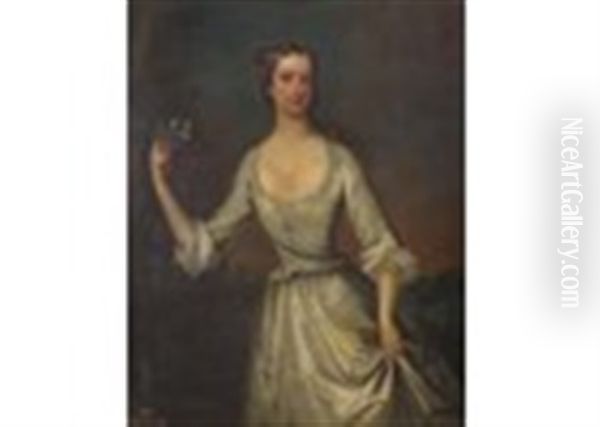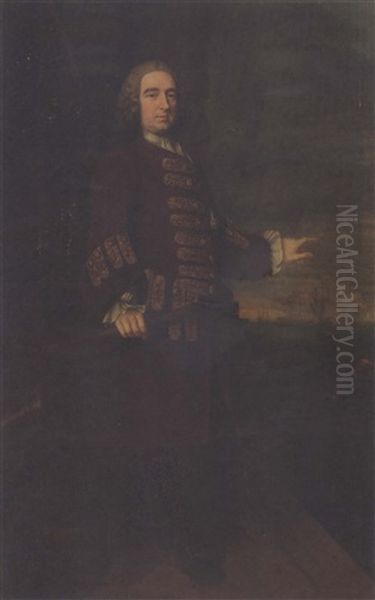Introduction: The Artist in His Time

Thomas Hudson (1701–1779) stands as one of the most significant and prolific portrait painters in England during the mid-eighteenth century. Born in Devon, near Bideford, his career unfolded primarily in London, the vibrant heart of the burgeoning British art world. He rose to prominence during a period when portraiture was the dominant genre, highly sought after by the aristocracy and the increasingly wealthy merchant class eager to cement their status through visual representation. Hudson became a master of capturing the likeness and, perhaps more importantly, the social standing of his sitters, establishing himself as a leading figure before the ascendancy of his own pupil, Sir Joshua Reynolds. His studio was among the most fashionable and successful in London during the 1740s and 1750s.
Hudson's journey into the art world began under the tutelage of Jonathan Richardson the Elder, a respected portraitist and writer on art theory. This apprenticeship was pivotal, not only shaping Hudson's technical skills but also connecting him to the established networks of London's artistic community. His connection to Richardson deepened further through marriage to Richardson's daughter, although sources suggest this union occurred without the father's initial blessing. This foundational period provided Hudson with the skills and connections necessary to launch his own successful practice, eventually making him a cornerstone of the Georgian art scene.
Early Life and Artistic Formation
Born into the early years of the 18th century in the county of Devon, Thomas Hudson's origins lie slightly outside the metropolitan centre of London, which he would later dominate professionally. His formative artistic training was crucial. He moved to London to study under Jonathan Richardson (1667-1745), who was not only a prominent portrait painter but also an influential writer whose theories on art and connoisseurship were widely read. Richardson's studio provided a rigorous environment where Hudson would have learned the fundamentals of drawing, painting techniques, and the business side of running a successful portrait practice.

The relationship with Richardson extended beyond the professional sphere. Hudson eventually married Mary Richardson, his master's daughter. This familial tie, even if initially strained, likely further integrated Hudson into the established art circles of London. Richardson's influence can be discerned in Hudson's early work, particularly in the solid, somewhat formal compositions and the careful attention to likeness, traits valued in the portraiture tradition inherited from Sir Godfrey Kneller. However, Hudson would soon develop his own distinct style, adapting to the evolving tastes of the era.
The Height of Fashion: Hudson's London Studio
By the 1740s, Thomas Hudson had established himself as one of London's most sought-after portrait painters. His studio became a hub of activity, attracting a distinguished clientele from the ranks of the nobility, gentry, and prominent public figures. This period, stretching roughly from the early 1740s to the mid-1750s, marked the zenith of his fame and commercial success. He operated a large and efficient studio, likely employing assistants and drapery painters to keep up with the high demand for his work. His ability to deliver consistently elegant and flattering likenesses made him a preferred choice for those wishing to be immortalized in paint.
During these peak years, Hudson's main rival for prestigious commissions was the Scottish painter Allan Ramsay (1713-1784). Both artists catered to a similar clientele and often competed directly for patronage. While Ramsay was perhaps noted for a slightly softer, more French-influenced delicacy, Hudson offered a robust elegance combined with a distinctly British sensibility. His success was such that he painted numerous members of the aristocracy, including dukes and earls, as well as significant figures from the intellectual and cultural spheres. His popularity is further attested by the fact that over 80 of his portraits were reproduced as engravings, disseminating his images to a wider public.
Artistic Style: Rococo Elegance and Technical Proficiency
Thomas Hudson's signature style is often characterized by its adoption of Rococo aesthetics, blended with the established traditions of British portraiture. His paintings typically feature high-saturation colours, lending vibrancy and richness to the canvases. He excelled in rendering the luxurious fabrics of the era – shimmering silks, velvets, and lace – paying meticulous attention to the details of costume, which served as important markers of the sitter's wealth and status. The depiction of lustrous white satin became something of a hallmark in his portraits of women.

His compositions often employed poses derived from earlier masters like Sir Anthony van Dyck and Sir Godfrey Kneller, as well as from his own teacher, Jonathan Richardson. These established formats provided a sense of dignity and gravitas appropriate for his clientele. While drawing on tradition, Hudson infused his works with the lighter, more graceful spirit of the Rococo. His portraits often convey an air of relaxed elegance, sometimes incorporating playful elements or suggesting a harmonious, refined atmosphere. The overall effect was one of sophistication and polish, perfectly suited to the tastes of Georgian high society.
Despite his technical skill and the undeniable appeal of his work, Hudson's style has sometimes been critiqued for a certain lack of profound psychological insight or groundbreaking innovation. While he captured excellent likenesses and conveyed social presence effectively, his approach tended towards the conventional. He mastered a successful formula but did not radically push the boundaries of portraiture in the way his pupil Reynolds later would. His strength lay in his reliability, his fine craftsmanship, and his ability to meet the expectations of his patrons with consistently elegant results.
Notable Works and Esteemed Sitters
Thomas Hudson's prolific output included portraits of some of the most eminent figures of his time. He is known to have painted King George II, a commission that underscores his standing at the pinnacle of his profession. Another celebrated sitter was the composer George Frideric Handel, whose portrait by Hudson remains one of the most iconic images of the musician. These commissions reflect Hudson's access to the highest levels of society and the cultural elite.
Beyond royalty and cultural giants, Hudson painted numerous members of the aristocracy and important institutional figures. Portraits such as that of Thomas Herring, Archbishop of Canterbury, demonstrate his role in documenting the leaders of the Church and State. He also engaged with the intellectual world, notably painting a portrait of the renowned natural philosopher Sir Isaac Newton, although this was likely posthumous or based on earlier likenesses, given Newton's death in 1727. His clientele extended to prominent families, as seen in works like The Radcliffe Family, a large "conversation piece" depicting multiple family members in a domestic setting, showcasing his ability to handle complex group compositions.

The sheer volume of his work is remarkable, with estimates suggesting he produced over 400 portraits during his career. The fact that so many were engraved speaks volumes about their contemporary popularity and the desire for wider circulation of these images. His portraits captured the likenesses of dukes, earls, politicians, clergymen, and society ladies, creating a comprehensive visual record of the Georgian establishment. Many of these works are now held in major public collections, including a significant number at the National Portrait Gallery in London.
Studio Practice, Assistants, and Collaboration
To manage the high volume of commissions during his peak years, Thomas Hudson operated a busy and well-organized studio. Like many successful portraitists of the era, he undoubtedly relied on the assistance of pupils and specialized painters. While the master would typically focus on the face and perhaps the overall composition, assistants might work on backgrounds, clothing, or copies. This division of labour was essential for maintaining productivity and meeting deadlines.
A particularly important aspect of studio practice at the time involved the painting of drapery and costume. Hudson frequently collaborated with specialist drapery painters, the most notable being the Flemish artist Joseph Van Aken (c. 1699-1749) and later his brother Alexander Van Aken (d. 1757). These specialists were highly skilled in rendering fabrics and complex folds, adding significantly to the luxurious finish of the portraits. Hudson's close working relationship with the Van Akens was common practice among leading London portraitists, including his rival Allan Ramsay. The portrait Joseph Vanhaeken (likely a misspelling or variant of Van Aken) is cited as a work demonstrating this collaborative relationship. This reliance on specialists allowed Hudson to focus his own efforts on capturing the sitter's likeness and character.
Hudson as Teacher: Shaping the Next Generation
Beyond his own artistic output, Thomas Hudson played a crucial role in training the next generation of British painters. His studio was a sought-after place for aspiring artists to learn the craft of portraiture. His most famous pupil was undoubtedly Sir Joshua Reynolds (1723-1792). Reynolds studied with Hudson from 1740 to 1743, acquiring foundational skills before embarking on his own travels and developing his distinct, more ambitious style. Although Reynolds would eventually eclipse his master in fame and influence, his time in Hudson's studio was a critical starting point.

Hudson's tutelage extended to other significant artists as well. Joseph Wright of Derby (1734-1797), celebrated for his dramatic scenes of science and industry and his mastery of light effects, also spent time as a pupil in Hudson's studio. Another notable student was John Hamilton Mortimer (c. 1740-1779), known for his historical subjects and romantic, sometimes turbulent, compositions. Mortimer's early development occurred under Hudson's guidance. By training these talented individuals, Hudson contributed significantly to the vitality and evolution of British art in the latter half of the 18th century, even as his own style began to seem more conservative compared to the innovations of his former pupils.
Competition, Contemporaries, and the London Art World
The London art world in the mid-18th century was a competitive environment, and Thomas Hudson was fully immersed in its rivalries and networks. His primary competitor in the field of fashionable portraiture was Allan Ramsay. Both artists vied for the most prestigious commissions, and patrons often chose between their distinct but equally elegant styles. This rivalry spurred both artists on and contributed to the high standard of portrait painting available in London at the time.
His relationship with his former pupil, Joshua Reynolds, evolved into a form of competition as Reynolds returned from Italy and began to introduce the "Grand Style," inspired by classical sculpture and Italian Renaissance masters. Reynolds aimed to elevate the status of portraiture by imbuing it with historical and mythological references, a different path from Hudson's more direct, albeit highly polished, approach. While Hudson maintained a successful practice, Reynolds's rising star power and intellectual ambition gradually shifted the prevailing taste, and Hudson's popularity began to wane in the late 1750s.
Hudson was also part of a wider circle of artists and cultural figures. He was acquainted with prominent contemporaries such as William Hogarth (1697-1764), the great painter and satirist, and Francis Hayman (1708-1776), a key figure in the development of British history painting and decorative schemes like those at Vauxhall Gardens. He also knew the celebrated Franco-Swiss sculptor Louis-François Roubiliac (1702-1762), whose dynamic terracotta models and marble busts were highly esteemed. These connections place Hudson firmly within the vibrant artistic milieu of Georgian London.
Hudson the Collector: Connoisseurship and Legacy
Like his master Jonathan Richardson, Thomas Hudson was not only a painter but also an avid collector and connoisseur of art. He amassed a significant collection of Old Master drawings and paintings, demonstrating a discerning eye and a deep appreciation for the history of European art. His collection reportedly included works attributed to giants such as Peter Paul Rubens, Anthony van Dyck, and Rembrandt van Rijn. This activity reflects a broader engagement with art beyond his own practice and aligns him with the tradition of the artist-collector.
His connoisseurship extended to participating in the art market. He is known to have associated with other collectors and possibly dealers, such as George Cheere and Henry Pitman, sometimes engaging in joint purchases. Collecting was not merely a private passion; it enhanced an artist's status and demonstrated their sophisticated understanding of art history. Upon Hudson's death in 1779, his substantial collection was dispersed through public auctions, held over three separate sales. These sales were significant events in the London art market, and the catalogues provide valuable insight into the scope and quality of the artworks he had acquired throughout his life. His collection activities further cemented his position as a knowledgeable figure within the art establishment of his day.
Later Years and Enduring Significance
As the artistic tide turned towards the grander ambitions promoted by Sir Joshua Reynolds and the nascent Royal Academy (founded in 1768), Thomas Hudson's style began to seem somewhat old-fashioned. Although he continued to work, the peak of his fashionable demand had passed by the late 1750s or early 1760s. He eventually retired from active painting, spending more time at his villa in Twickenham, enjoying the fruits of his successful career and focusing on his collection. He passed away in Twickenham in 1779.
While his fame was eventually overshadowed by Reynolds, Hudson's contribution to British art remains undeniable. He was arguably the leading portrait painter in London during a crucial period of transition, bridging the era of Kneller with the rise of Reynolds and Gainsborough. His technical proficiency, his elegant Rococo-infused style, and his ability to capture the likeness and status of his sitters set a high standard for portraiture. Furthermore, his role as a teacher was profoundly influential, launching the careers of several major artists who would define the next chapter of British painting.
Today, Thomas Hudson is recognized as a key figure in the history of British art. His numerous portraits provide invaluable visual documentation of Georgian society. While perhaps lacking the innovative spark of genius attributed to some of his contemporaries or successors, his work embodies the solid craftsmanship, refined taste, and professional success that characterized the best of mainstream British portraiture in the mid-18th century. His paintings are preserved in numerous public and private collections, ensuring his legacy as a master of the Georgian portrait.
Conclusion: A Master of Georgian Portraiture
Thomas Hudson occupies a vital place in the narrative of 18th-century British art. As a successor to the tradition of Kneller and Richardson, and as the master of Reynolds and Wright of Derby, he forms a crucial link between different phases of artistic development. For nearly two decades, his London studio was the destination of choice for the British elite seeking elegant and reliable portraits. His style, blending Rococo grace with established portrait conventions, perfectly captured the aspirations and self-image of Georgian society.
His prolific output, meticulous technique, particularly in rendering costumes, and his successful management of a large studio practice testify to his professionalism and skill. While later eclipsed by the innovations of his own students, Hudson's influence persisted through their work and through his own substantial body of portraits. He was more than just a painter; he was a teacher, a collector, and a central figure in the London art world. Thomas Hudson remains an indispensable artist for understanding the character and visual culture of Georgian England.